List of United States Naval Academy alumni
 From Wikipedia - Reading time: 60 min
From Wikipedia - Reading time: 60 min

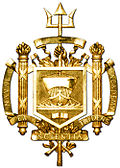
The United States Naval Academy (USNA) is an undergraduate college in Annapolis, Maryland with the mission of educating and commissioning officers for the United States Navy and Marine Corps. The Academy was founded in 1845 and graduated its first class in 1846. The Academy is often referred to as Annapolis, while sports media refer to the Academy as "Navy" and the students as "Midshipmen"; this usage is officially endorsed.[1] During the latter half of the 19th century and the first decades of the 20th, the United States Naval Academy was the primary source of U.S. Navy and Marine Corps officers, with the Class of 1881 being the first to provide officers to the Marine Corps. Graduates of the Academy are also given the option of entering the United States Army or United States Air Force. Most Midshipmen are admitted through the congressional appointment system.[2] The curriculum emphasizes various fields of engineering.[3]
The list is drawn from graduates, non-graduate former Midshipmen, current Midshipmen, and faculty of the Naval Academy. Over 50 U.S. astronauts have graduated from the Naval Academy, more than from any other undergraduate institution.[a] Over 990 noted scholars from a variety of academic fields are Academy graduates, including 45 Rhodes Scholars and 16 Marshall Scholars. Additional notable graduates include 1 President of the United States, 2 Nobel Prize recipients, and 73 Medal of Honor recipients.[b]
Medal of Honor recipients
[edit]Academics
[edit]- "Class year" refers to the alumni's class year, which usually is the same year they graduated. However, in times of war, classes often graduate early. For example, the Class of 1943 actually graduated in 1942.
|
   |
Astronauts
[edit]
|
 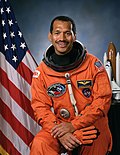  |
Athletes
[edit]Basketball players
[edit]
|
 |
Football players
[edit]
|
   |
Olympics competitors
[edit]
|
 |
Other sports figures
[edit]
|
Attorneys
[edit]
|
Businesspeople
[edit]
|
 |
U.S. Government
[edit]President of the United States
[edit]
|
U.S. Cabinet members
[edit]
|
Secretaries of military services
[edit]
|
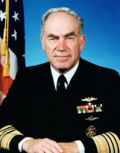 |
U.S. legislators
[edit]
|
  |
National Security advisers
[edit]
|
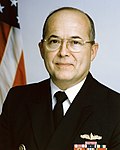 |
Chairmen of the Joint Chiefs of Staff
[edit]
|
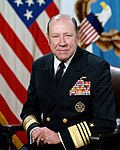 |
Vice Chairmen of the Joint Chiefs of Staff
[edit]
|
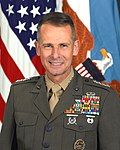 |
Ambassadors
[edit]
|
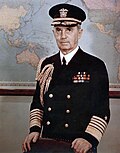 |
Governors
[edit]
|
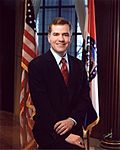 |
Literary figures
[edit]
|
 |
Military figures
[edit]Chiefs of Naval Operations
[edit]
|
  |
Commandants of the Marine Corps
[edit]
|
  |
Confederate States Navy officers
[edit]
|
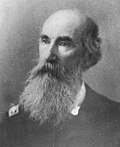  |
Union Navy officers
[edit]
|
 |
Spanish–American War combatants
[edit]
|
 |
Boxer Rebellion combatants
[edit]
|
World War I combatants
[edit]
|
  |
Spanish Civil War combatant
[edit]
|
World War II combatants
[edit]
|
Korean War combatants
[edit]
|
Vietnam War combatants
[edit]
|
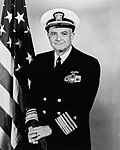  |
Lebanon combatants
[edit]
|
Panama combatants
[edit]
|
Combatants of wars in Iraq and Afghanistan
[edit]
|
 |
Scientists
[edit]
|
  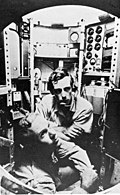 |
Television figures
[edit]
|
Notable fictional alumni
[edit]This section needs additional citations for verification. (December 2021) |
|
Faculty
[edit]- These faculty are not graduates, consequently their class year is listed as "NA" for 'not applicable' and they are listed alphabetically by last name.
|
 |
Distinguished International Alumni
[edit]
|
 |
See also
[edit]References
[edit]- General
^ a: "Astronauts". United States Naval Academy. 2017. Retrieved 2017-05-16.
^ b: "Notable Graduates". United States Naval Academy. 2017. Retrieved 2017-05-16.
^ c: "State Governors". United States Naval Academy. 2017. Retrieved 2017-05-16.
^ d: "Nobel Prize Winners". United States Naval Academy. 2017. Retrieved 2017-05-16.
^ e: "Commandant of the Marine Corps". United States Naval Academy. 2017. Retrieved 2017-05-16.
^ f: "Medal of Honor Recipients". United States Naval Academy. 2017. Retrieved 2017-05-16.
^ g: "United States Ambassadors". United States Naval Academy. 2017. Retrieved 2017-05-16.
^ h: "Chairmen of the Joint Chiefs of Staff". United States Naval Academy. 2017. Retrieved 2017-05-16.
^ i: "Chief of Naval Operations". United States Naval Academy. 2017. Retrieved 2017-05-16.
^ j: "Cabinet Members". United States Naval Academy. 2017. Retrieved 2017-05-16.
^ k: "Rhodes Scholars". United States Naval Academy. 2017. Retrieved 2017-05-16.
^ l: "Secretaries of the Navy". United States Naval Academy. 2017. Retrieved 2017-05-16.
^ m: "Congress Members". United States Naval Academy. 2017. Retrieved 2017-05-16.
^ n: "Vice Chairmen of the Joint Chiefs of Staff". United States Naval Academy. 2017. Retrieved 2017-05-16.
- Inline citations
- ^ "Apply For Nomination". United States Naval Academy. 2009. Retrieved 2009-02-08.
- ^ "Academic Education". United States Naval Academy. 2009. Retrieved 2009-02-08.
- ^ a b Parker, William H. (1985) [1883]. Craig Symonds (ed.). Recollections of a Naval Officer, 1841–1865. Annapolis, Maryland: Naval Institute Press.
- ^ "William Harwar Parker". Civil War Reference. Archived from the original on 2011-07-08. Retrieved 2009-02-25.
- ^ Ebarb, Matthew A. (2007-10-02). "Midshipmen Learn Lessons from the Fleet". Story Number: NNS071020-04. Navy News. Archived from the original on August 5, 2012. Retrieved 2017-05-12.
- ^ Livezey, William E. (1947). Mahan on Sea Power (1981 reprint ed.). Norman, Oklahoma: University of Oklahoma Press.
- ^ Allard, Dean C. (April 1975). "Admiral William S. Sims and United States Naval Policy in World War I". American Neptune. 35 (35): 97–110.
- ^ Allard, Dean C. (April 1975). "Admiral William S. Sims and United States Naval Policy in World War I". American Neptune. 35: 97–110.
- ^ "Edward W. Eberle Class of 1885". United States Naval Academy. Retrieved 2017-05-16.
- ^ a b "John A. Lejeune Class of 1888". United States Naval Academy. Retrieved 2017-05-12.
- ^ a b c d e f g h i j Millett, Allan Reed; Jack Shulimson (2004). Commandants of the Marine Corps. Annapolis, Maryland: Naval Institute Press. ISBN 0-87021-012-2.
- ^ "USS Emory S. Land (AS 39)". Navy Site. Retrieved 2009-02-10.
- ^ "Superintendents of the U.S. Naval Academy". United States Naval Academy. Retrieved 2009-02-20.
- ^ Baldwin, Hanson W. (November 27, 1946). "Navy's Holloway Plan; 5,000 to Be Chosen for College Training Leading to Commissions". The New York Times. p. 16.
- ^ "Captain Edward J. O'Donnell File". Retrieved 19 April 2020.
- ^ Flint, Peter B. (1990-03-08). "William Appleman Williams Dies; Gadfly of Foreign Policy Was 68". The New York Times. Retrieved 2009-02-11.
- ^ "Stansfield Turner". Harvard Square. Archived from the original on February 10, 2009. Retrieved 2009-02-16.
- ^ Snepp, Frank (1999). Irreparable Harm: A Firsthand Account of How One Agent Took On the CIA in an Epic Battle Over Secrecy and Free Speech. New York: Random House. p. 242. ISBN 0-7006-1091-X.
- ^ a b "Admiral Carlisle A. H. Trost Class of 1953". United States Naval Academy. Retrieved 2017-05-16.
- ^ a b Halloran, Richard (1986-05-30). "2 Career Men Who Worked Their Way to the Top of Navy and Air Force: Carlisle Albert Herman Trost". The New York Times. p. Section A, Page 11, Column 1. Retrieved 2009-02-21.
- ^ a b "Olmstead Scholars". United States Naval Academy. Retrieved 2009-03-15.
- ^ Michael, Mark (November 28, 2022). "Anglican Realignment Pioneer John Rodgers Dies at 92". The Living Church. Retrieved 6 January 2023.
- ^ "Evangelical Seminary to Get New Dean". Episcopal News Service. July 13, 1978. Retrieved 6 January 2023.
- ^ "Dennis C. Blair Director of National Intelligence". Office of the Director of National Intelligence. Archived from the original on February 2, 2009. Retrieved 2009-02-16.
- ^ "Ronald K. Machtley Class of 1970". United States Naval Academy. Retrieved 2017-05-16.
- ^ "Machtley, Ronald K." Biographical Directory of the United States Congress. United States Congress. Retrieved 2009-03-04.
- ^ "Alan B. Shepherd Class of 1945". United States Naval Academy. Retrieved 2017-05-16.
- ^ "Alan B. Shepard, Jr. (Rear Admiral, USN, Ret.)". National Aeronautics and Space Administration (NASA). Retrieved 2009-02-15.
- ^ "James A. Lovell Class of 1952". United States Naval Academy. Retrieved 2017-05-16.
- ^ "James A. Lovell, Jr. (Captain, USN, Ret.)". NASA. Retrieved 2009-02-15.
- ^ "Charles F. Bolden Class of 1968". United States Naval Academy. Retrieved 2017-05-16.
- ^ "Charles F. Bolden, Jr. (Brig. General, USMC)". NASA. Archived from the original on 2009-02-01. Retrieved 2009-02-15.
- ^ "Kenneth D. Bowersox Class of 1978". United States Naval Academy. Retrieved 2017-05-16.
- ^ "Kenneth D. Bowersox (Captain, USN)". NASA. Archived from the original on 2009-01-17. Retrieved 2009-02-15.
- ^ a b "Wendy B. Lawrence Class of 1981". United States Naval Academy. Retrieved 2016-05-17.
- ^ "Wendy B. Lawrence (Captain, USN)". NASA. Archived from the original on 2009-02-18. Retrieved 2009-02-15.
- ^ "William C. McCool (Commander, USN) NASA Astronaut (Deceased)" (PDF). NASA. May 2004. Retrieved April 14, 2021.. Note: this text, the work of a U.S. Government agency, is a work in the public domain.
- ^ Kershaw, Sarah. Space Shuttle Widow Is Ready to Move on From Rituals of Loss, New York Times, December 5, 2007. Retrieved August 15, 2010.
- ^ "Congressional Space Medal of Honor". NASA. Retrieved November 25, 2022.
- ^ "Astronaut Biography: Kayla Barron".
- ^ a b "Navy Men's Basketball: A Tradition of Excellence". NavySports. CBS Sports. 2010. Archived from the original on 2010-05-26. Retrieved 2010-04-30.
- ^ a b "Division I Consensus All-American Selections" (PDF). Award Winners. NCAA. 2008. p. 134. Retrieved 2010-04-30.
- ^ "Loughlin, Charles Elliott (1910–1989)". United States Naval Institute. 2011. Retrieved 2012-01-09.
- ^ "One-on-One with Cavaliers Assistant Coach Hank Egan". Cleveland Cavaliers. Retrieved 2009-02-14.
- ^ "David Robinson Class of 1987". United States Naval Academy. Archived from the original on January 18, 2009. Retrieved 2009-02-14.
- ^ "Naismith Memorial Basketball Hall of Fame Announces Five Members as the Class of 2009" (Press release). Naismith Memorial Basketball Hall of Fame. 2009-04-06. Archived from the original on 2009-04-09. Retrieved 2009-05-24.
- ^ "Doug Wojcik: Bio". University of Tulsa Athletic Department. Archived from the original on 2014-10-20. Retrieved 2010-03-27.
- ^ "College of Charleston fires men's hoop coach Doug Wojcik following verbal abuse allegations". Fox News. Associated Press. August 5, 2014. Retrieved October 20, 2014.
- ^ College Football Hall of Fame profile
- ^ College Football Hall of Fame profile
- ^ College Football Hall of Fame profile
- ^ "Leon C. "Lee" Bramlett". msfame.com. Archived from the original on May 24, 2014. Retrieved May 6, 2014.
- ^ "Bob McElwee Haddonfield, New Jersey". National Association of Sports Officials. Archived from the original on 2007-09-28. Retrieved 2009-02-08.
- ^ "Bob "Reef" Reifsnyder". College Football Hall of Fame. Archived from the original on 2015-02-05. Retrieved 2017-10-31.
- ^ "27 Joe Bellino HB". New England Patriots. Retrieved 2010-02-08.[permanent dead link]
- ^ "Roger Staubach". United States Naval Academy. Archived from the original on January 19, 2009. Retrieved 2009-02-08.
- ^ "O'Brien Touts Military Appreciation Day". North Carolina State University. Retrieved 2009-02-08.
- ^ "John Dickson Stufflebeem". Archived from the original on 2012-10-26. Retrieved 2010-04-27.
- ^ "Remembering Three Navy Legends". Navy Sports.com. Retrieved 2009-02-08.
- ^ "Napoleon McCallum Trophy". United States Naval Academy. Retrieved 2009-02-08.
- ^ "Laning". Directory of American Naval Fighting Ships. Archived from the original on 2010-04-11. Retrieved 2009-02-14.
- ^ "Shooting at the 1912 Stockholm Summer Games: Men's Military Rifle, 200, 400, 500 and 600 metres, Team". Sports Reference. 2009. Archived from the original on 2020-04-18. Retrieved 2009-02-14.
- ^ Bergvall, Erik, ed. (1913). The Official Report of the Olympic Games of Stockholm 1912. Translated by Adams-Ray, Edward. Stockholm: Wahlström & Widstrand.
- ^ "Papers of Captain Carl Townsend Osburn, USN, 1903–1964". Naval Historical Center. 2006-11-29. Archived from the original on 2008-10-08. Retrieved 2009-02-15.
- ^ Sherrington, Kevin (2008-08-23). "Phelps remains perfect with five Olympic gold medals". Dallas Morning News. Archived from the original on 2013-01-20. Retrieved 2009-02-15.
- ^ a b c d e f g h i Saint Sing, Susan (2004). "1920 Navy Olympic Crew". Glendon. Archived from the original on 2009-04-06. Retrieved 2009-02-14.
- ^ Gjerde, Arild; Jeroen Heijmans; Bill Mallon; Hilary Evans. "Tom Connolly Bio, Stats, and Results". Olympics. Sports Reference.com. Archived from the original on April 18, 2020. Retrieved February 5, 2018.
- ^ a b c d e f g h i "Navy's '52 Olympic Gold Medal Crew Team to Hold Reunion". Navy Sports. 2002-09-26. Retrieved 2009-02-14.
- ^ a b "Peter Blair to be Inducted into National Wrestling Hall of Fame". NavySports.com. 5 June 2009. Archived from the original on 2016-01-14. Retrieved 2012-01-10.
- ^ "FIFA: Casey Bahr". Federation Internationale de Football Association. Archived from the original on August 27, 2012. Retrieved 2011-02-02.
- ^ a b "Dr John J. McMullen '40". United States Naval Academy. Archived from the original on January 15, 2009. Retrieved 2009-02-14.
- ^ Robson, Douglas (April 23, 2014). "How a trophy found at garage sale revived forgotten champ's legacy". USA Today. Retrieved May 14, 2014.
- ^ "Brian Stann UFC profile". 14 September 2018.
- ^ "Brian Stann".
- ^ Billy Hurley III
- ^ "Noah Song". Navy Sports. Retrieved 2021-08-06.
- ^ Ichabod S. Bartlett, History of Wyoming, Volume 3 (1918), p. 389.
- ^ "Navigating an odyssey to Guantánamo Bay". National Law Journal. December 2005. Archived from the original on 2007-03-11.
- ^ "LCDR Charles D. Swift". Association of Graduates of the United States Military Acadedmy. Archived from the original on 2008-08-29. Retrieved 2009-02-08.
- ^ "J. F. Geisse, 71, Who Founded Discount Stores". The New York Times. 27 February 1992. Retrieved 2017-05-16.
- ^ "H. Ross Perot Class of 1953". United States Naval Academy. Archived from the original on January 18, 2009. Retrieved 2009-02-09.
- ^ Townley, Alvin (2006-12-26). Legacy of Honor: The Values and Influence of America's Eagle Scouts. New York: St. Martin's Press. pp. 89–100, 108, 187, 194, 249, 260, 265. ISBN 0-312-36653-1. Retrieved 2013-08-12.
- ^ "Ernst Volgenau Honored with George Mason Medal". George Mason University News. May 10, 2013. Retrieved 2013-08-27.
- ^ "Volgenau Audience Challenged to Embrace "Courageous Followership"" (PDF). Taking Stock. VAdm Stockdale Center for Ethical Leadership. Spring 2013. p. 4. Retrieved 2013-08-27.
The Volgenau Honor Courage and Commitment Semniar Series is made possible by Dr. Ernst Volgenau, USNA Class of 1955, and his wife, Sarah.
- ^ Lucky Bag. Annapolis, Maryland. 1955. p. 446. Retrieved 2013-08-27.
{{cite book}}: CS1 maint: location missing publisher (link) - ^ "Dr. Jack P. London". CACI, Inc. 2015. Retrieved 16 April 2015.
- ^ "Profiles in Giving". United States Naval Academy. Retrieved 2008-06-24.
- ^ a b "The Honorable Richard L. Armitage". Armitage International. Archived from the original on February 19, 2008. Retrieved 2009-02-14.
- ^ a b "History of the NROTC Unit at Georgia Institute of Technology". Georgia Tech NROTC. 4 November 2012. Retrieved 2017-05-12.
- ^ a b "James Earl "Jimmy" Carter Class of 1947". United States Naval Academy. Retrieved 2017-05-12.
- ^ "James D. Watkins Class of 1949". United States Naval Academy. Archived from the original on January 17, 2009. Retrieved 2009-02-14.
- ^ "Anthony Prinicpi Class of 1967". United States Naval Academy. Archived from the original on January 17, 2009. Retrieved 2009-02-14.
- ^ "Curtis Dwight Wilbur Class of 1888". United States Naval Academy. Archived from the original on January 17, 2009. Retrieved 2009-02-21.
- ^ Rehnquist, William (2002-10-11). "Remarks of The Chief Justice Federal Judicial Center National Symposium United States Court of Appeals Judges". Supreme Court of the United States. Retrieved 2009-02-22.
- ^ "Robert B. Pirie Jr. Class of 1955". United States Naval Academy. Archived from the original on January 17, 2009. Retrieved 2009-02-21.
- ^ "The Honorable Robert B. Pirie, Jr. Secretary of the Navy (Acting)". Northrop Grumman. Archived from the original on 2006-03-16. Retrieved 2009-02-22.
- ^ "Frank B. Kelso Class of 1956". United States Naval Academy. Archived from the original on January 19, 2009. Retrieved 2009-02-21.
- ^ "Announcement of the Appointment of Admiral Frank B. Kelso II as Supreme Allied Commander, Atlantic". University of Texas. 1988-06-01. Retrieved 2009-02-21.
- ^ "John H. Dalton Class of 1964". United States Naval Academy. Archived from the original on January 17, 2009. Retrieved 2009-02-21.
- ^ "John H. Dalton". Executive Biographies. The Financial Services Roundtable. Archived from the original on January 19, 2009. Retrieved 2009-02-22.
- ^ a b c d e f g h i Timberg, Robert (1996-09-11). The Nightingale's Song. New York: Simon & Schuster. pp. 13–14, 31. ISBN 0-684-82673-9. Retrieved 2009-02-11.
the nightingale's song.
- ^ a b c "James H. Webb Class of 1968". United States Naval Academy. Archived from the original on January 19, 2009. Retrieved 2009-02-21.
- ^ "Thomas B. Modly > U.S. Department of Defense > Biography". Defense.gov. United States Department of Defense. Retrieved April 7, 2020.
- ^ "Guantanamo says goodbye to last Cuban 'commuters'". AP News. December 14, 2012.
- ^ Cite error: The named reference
POLwas invoked but never defined (see the help page). - ^ Officer, Public Affairs (2021-08-11). "Congratulations to Carlos Del Toro, the 78th Secretary of the Navy | Association of Naval Services Officers". Retrieved 2024-06-23.
- ^ a b "Denton, Jeremiah Andrew". Biography. POW Network. Retrieved 2009-02-15.
- ^ a b "Jeremiah Andrew Denton Class of 1947 (sic)". United States Naval Academy. Archived from the original on May 28, 2010. Retrieved 2009-02-15.
- ^ "Denton, Jeremiah Andrew, Jr". Biographical Directory of the United States Congress. United States Congress. Retrieved 2009-03-04.
- ^ a b "John McCain". Biographical Directory of the United States Congress. United States Congress. Retrieved 2009-03-02.
- ^ a b Bernstein, Richard (1999-10-01). "Books of the Times; Standing Humbly Before a Noble Family Tradition". The New York Times. Retrieved 2009-02-27.
- ^ "Richmond P. Hobson". United States Naval Academy. Archived from the original on January 18, 2009. Retrieved 2009-02-16.
- ^ "Medal of Honor Recipients War With Spain". United States Army Center of Military History. Archived from the original on 2009-04-23. Retrieved 2009-02-26.
- ^ "Richmond Pearson Hobson Class of 1898 (sic)". United States Naval Academy. Archived from the original on January 19, 2009. Retrieved 2009-03-03.
- ^ "Richmond Pearson Hobson". Biographical Directory of the United States Congress. United States Congress. Retrieved 2009-03-03.
- ^ "Another way to serve: After 20 years in Navy, Elaine Luria running for Congress". elaineforcongress.com. 2018-03-07. Archived from the original on 2019-04-16. Retrieved 2024-02-12.
- ^ "Tim Sheehy". U.S. Naval Institute. Retrieved October 22, 2024.
- ^ "Tim Sheehy". Simon & Schuster. Retrieved 2024-10-22.
- ^ "Mikie Sherrill Class of 1994". United States Naval Academy. Retrieved 2020-09-20.
- ^ "Mikie Sherrill Biography". Ballotpedia. Retrieved 2020-09-20.
- ^ "Webb, James H. (Jim)". Biographical Directory of the United States Congress. United States Congress. Retrieved 2009-03-04.
- ^ "Charles Nesbit Wilson Class of 1956". United States Naval Academy. Archived from the original on December 12, 2009. Retrieved 2009-02-12.
- ^ "Charles Wilson". Biographical Directory of the United States Congress. United States Congress. Retrieved 2009-03-02.
- ^ Sutherland, John (2002-02-18). "No more Mr Scrupulous Guy". London: Guardian UK. Retrieved 2009-02-12.
- ^ Estrada, Louie (1999-05-13). "Adm. James 'Bud' Nance Dies". Washington Post. ISSN 0190-8286. Retrieved 2020-11-25.
- ^ "Arthur W. Radford Class of 1916". United States Naval Academy. Archived from the original on January 17, 2009. Retrieved 2009-02-12.
- ^ "Thomas H. Moorer Class of 1933". United States Naval Academy. Archived from the original on January 17, 2009. Retrieved 2009-02-13.
- ^ a b "Admiral William J. Crowe Class of 1947". United States Naval Academy. Archived from the original on January 17, 2009. Retrieved 2009-02-13.
- ^ a b "Peter Pace Class of 1967". United States Naval Academy. Archived from the original on January 17, 2009. Retrieved 2009-02-12.
- ^ "Michael G. Mullen of 1968". United States Naval Academy. Archived from the original on February 10, 2009. Retrieved 2009-02-13.
- ^ "Robert T. Herres Class of 1954". United States Naval Academy. Archived from the original on January 17, 2009. Retrieved 2009-03-01.
- ^ Robles, Jr., Josue (2008-07-25). "CEO Message: Remembering General Herres". United Services Automobile Association (USAA). Retrieved 2009-03-01.
- ^ "William A. Owens Class of 1962". United States Naval Academy. Archived from the original on January 17, 2009. Retrieved 2009-03-01.
- ^ "Nortel Announces Mike Zafirovski as President and CEO". CCNMatthews.com. 2009-03-01. Archived from the original on 2006-02-25. Retrieved 2008-05-05.
- ^ "Executive Management: General Peter Pace, USMC (Ret.)". SM&A. Archived from the original on 2009-02-24. Retrieved 2009-03-01.
- ^ "Edmund P. Giambastiani Class of 1970". United States Naval Academy. Archived from the original on January 17, 2009. Retrieved 2009-03-01.
- ^ "Admiral Edmund P. Giambastiani, Jr., U.S. Joint Forces Command/North Atlantic Treaty Organization". United States Joint Forces Command. Archived from the original on September 28, 2007. Retrieved 2009-03-01.
- ^ "William H. Standley Class of 1895". United States Naval Academy. Archived from the original on January 19, 2009. Retrieved 2009-02-19.
- ^ a b "Raymond A. Spruance". Naval History and Heritage Command. Archived from the original on June 20, 2004. Retrieved 2010-04-26.
- ^ "Admiral Horacio Rivero Class of 1931". United States Naval Academy. Archived from the original on January 17, 2009. Retrieved 2009-02-13.
- ^ "William Anders Class of 1955". United States Naval Academy. Archived from the original on January 17, 2009. Retrieved 2009-02-14.
- ^ "Public Alumni Lookup". United States Naval Academy. Retrieved 2010-03-03.
- ^ Binns, Jack R. (2001). "Weighing Bush's Foreign Policy". The Forum. 1 (1). The Berkeley Electronic Press. doi:10.2202/1540-8884.1001. S2CID 145073773. Archived from the original on 2009-02-10. Retrieved 2010-03-03.
- ^ "Admiral Joseph W. Prueher Class of 1964". United States Naval Academy. Archived from the original on January 17, 2009. Retrieved 2009-02-14.
- ^ "Reuben E. Brigety, II, Class of 1995". United States Naval Academy. Retrieved 2016-03-09.
- ^ The Encyclopedia of the Spanish–American and Philippine–American Wars, Volume 1 (2009), Tucker, Spencer C., ABC CLIO, Santa Barbara, CA
- ^ United States Naval Academy (1902). Class of '71, United States Naval Academy, Annapolis, Md. New York City: The Grafton Press.
- ^ "Capt. Templin M. Potts: Retired Navy Officer, Former Governor of Guam, Is Dead". The New York Times. 23 March 1927. p. 25. Retrieved 2013-08-12.
- ^ Hamersly, Lewis Randolph (1902). The Records of Living Officers of the U.S. Navy and Marine Corps. L.R. Hamersly. p. 285. Retrieved 2010-11-21.
- ^ "Naval Era Governors of Guam". Guampedia. Guam: University of Guam. 10 August 2010. Archived from the original on 11 July 2011. Retrieved 2010-10-29.
- ^ "Naval Era Governors of Guam". Guampedia. University of Guam. Archived from the original on 2011-07-11. Retrieved 2016-03-10.
- ^ Hamersly, Lewis Randolph (1902). The Records of Living Officers of the U.S. Navy and Marine Corps: With a History of Naval Operations During the Rebellion of 1861-5, and a List of the Ships and Officers Participating in the Great Battles. J.M. Carroll. p. 216. Retrieved 2009-10-05.
- ^ "Commander John Martin Poyer: March 1, 1915 – June 10, 1919". Government of American Samoa. 2009. Archived from the original on June 1, 2009. Retrieved 2009-10-06.
- ^ "Robert E. Coontz Class of 1885". United States Naval Academy. Archived from the original on January 19, 2009. Retrieved 2009-02-19.
- ^ "William Wirt Gilmer". Military Times. Gannett Government Media. 2011. Archived from the original on 14 July 2011. Retrieved 2011-01-27.
- ^ "ADMIRAL HOUGH DIES HERE AT 72". New York Times. Sep 10, 1943. pg. 23, 1 pgs
- ^ "The Naval Graduates; Forty-Four Cadets To Leave the Annapolis Academy To-day". The New York Times. 10 June 1887. p. 2. Retrieved 2009-12-01.
- ^ Sorensen, Stan (21 December 2007). "Historical Notes" (PDF). Tapuitea: Official American Samoa Government Weekly Newspaper. II (31). Government of American Samoa: 2. Archived from the original (PDF) on May 27, 2010. Retrieved 2009-12-01.
- ^ Hamersly, Lewis Randolph (1902). The Records of Living Officers of the U.S. Navy and Marine Corps: With a History of Naval Operations During the Rebellion of 1861-5, and a List of the Ships and Officers Participating in the Great Battles. J.M. Carroll. Retrieved 2009-10-04.
- ^ "Valor Awards for Adelbert Althouse". Military Times. Gannett Government Media. Archived from the original on 14 July 2011. Retrieved 2011-03-01.
- ^ "Admiral M'Namee Dead in Newport: Former Head of Mackay Radio, Adviser at 1919 Paris Peace Parley, in Navy 42 Years". The New York Times. The New York Times Company. 31 December 1952. p. 15. Retrieved 2013-08-12.
- ^ "Captain Edward Stanley Kellogg, USN: An Inventory of His Collection in the Navy Department Library". Washington, D.C.: Naval History & Heritage Command. July 20, 2004. Archived from the original on July 8, 2010. Retrieved 2010-07-04.
- ^ "Class of '94, Naval Academy" (PDF). The New York Times. The New York Times Company. 4 June 1894.
- ^ "Six-Year Cadets Assigned to Duty" (PDF). The New York Times. 2 July 1895. Retrieved 2011-03-22.
- ^ Hamersly, Lewis Randolph (1902). The Records of Living Officers of the U.S. Navy and Marine Corps. L. R. Hamersly. Retrieved 2010-01-13.
- ^ United States Naval Academy (1899). Annual Register of the U.S. Naval Academy. Washington, D.C.: United States Government Printing Office. p. 47. Retrieved 2010-02-12.
- ^ Government of American Samoa (2010). "Lieutenant Nathan Woodworth Post". American Samoa. Archived from the original on May 27, 2010. Retrieved 2010-02-11.
- ^ "Valor Awards for Ivan Cyrus Wettengel". Military Times. Gannett Government Media. 2011. Archived from the original on 30 August 2012. Retrieved 2011-06-12.
- ^ "Valor Awards for William Pigott Cronan". Military Times. Gannett Government Media. 2011. Archived from the original on 26 August 2012. Retrieved 2011-06-08.
- ^ "Capt. O. C. Dowling: Former Governor of American Samoa Dies Driving Auto". The New York Times. 15 April 1946. p. 27. Retrieved 2013-08-12.
- ^ Associated Press (11 November 1936). "Sleepy Are Samoan Days". Pittsburgh Post-Gazette. p. 8. Retrieved 2010-03-01.
- ^ Catalogue. Washington, D.C.: George Washington University. 1913. p. 284. Retrieved 2011-01-15.
- ^ Class Of 1898, United States Naval Academy (1898). "The Lucky Bag of the United States Naval Academy". p. 41. Retrieved 2010-02-22.
{{cite web}}: CS1 maint: numeric names: authors list (link) - ^ Sorensen, Stan (16 May 2008). "Historical Notes" (PDF). Tapuitea. III (20). Government of American Samoa: 2. Archived from the original (PDF) on November 27, 2008. Retrieved 2010-02-22.
- ^ "Find Athletes Good Students: Naval Academy Board Makes Report After Scanning Records of Thirty Years". The Woodville Republican. Woodville, Mississippi: Boyd. 22 April 1922. p. 6. Retrieved 2010-03-21.
- ^ "Captain McGillivray Milne". Government of American Samoa. 2009. Archived from the original on June 1, 2009. Retrieved 2010-03-21.
- ^ "Blackburn, Morgan, and Post Get Their Commissions". Omaha World-Herald. Vol. XLI, no. 148. Omaha, Nebraska. 25 February 1906. p. 3.
- ^ United States Congressional Serial Set. Washington, D.C.: United States Government Printing Office. 1902. p. 88. Retrieved 2011-04-07.
- ^ List and station of the commissioned and warrant officers of the Navy of the United States: and of the Marine Corps, on the active list, and officers on the retired list employed on active duty. Washington, D.C.: United States Government Printing Office. 1898. p. 48. Retrieved 2010-06-30.
Charles Armijo Woodruff.
- ^ Associated Press (21 March 1933). "Governor of Guam Named; Capt. G.A. Alexander of the Navy Appointed by Roosevelt". The New York Times. p. 4.
- ^ "Willis Winter Bradley Class of 1907". United States Naval Academy. Archived from the original on January 18, 2009. Retrieved 2009-02-23.
- ^ "Willis W. Bradley". Biographical Directory of the United States Congress. United States Congress. Retrieved 2009-02-23.
- ^ "Medal of Honor Recipients World War I". United States Army Center of Military History. Archived from the original on 2008-10-18. Retrieved 2009-02-26.
- ^ "Captain A. W. Brown, U.S. Navy, Detached from Command by Death". Broadside. XIV. United States Navy. 17 September 1933. Retrieved 2011-03-24.
- ^ "William Adams Hodgman". Military Times. Gannett Government Media. 2011. Archived from the original on 31 July 2012. Retrieved 2011-01-27.
- ^ "Benjamin Vaughan McCandlish". Military Times. Gannett Government Media. 2011. Archived from the original on 26 August 2012. Retrieved 2011-05-18.
- ^ "Samuel Wilder King Class of 1910". United States Naval Academy. Archived from the original on January 18, 2009. Retrieved 2009-03-02.
- ^ "KING, Samuel Wilder, (1886–1959)". Biographical Directory of the United States Congress. United States Congress. Retrieved 2009-03-02.
- ^ a b "Japanese Fishing Vessel Wrecked on Guam in Area Closed to Aliens; 24 of Crew Saved". The New York Times. 16 January 1940. p. 12.
- ^ Congressional Serial Set. Washington, D.C.: United States Government Printing Office. 1913. p. 134. Retrieved 2010-07-03.
- ^ "Will Marry on Warship: Mrs. Gertrude B. Childs to Wed Lieut. A. T. Emerson in Naples". The New York Times. 27 November 1921. p. 22.
- ^ Register of Commissioned and Warrant Officers of the United States Navy and Marine Corps and Reserve Officers on Active Duty. Bureau of Naval Personnel. 1918. p. 260. Retrieved 2010-05-02.
- ^ Register of Commissioned and Warrant Officers of the United States Navy and Marine Corps and Reserve Officers on Active Duty. Bureau of Naval Personnel. 1918. p. 262. Retrieved 2010-05-02.
- ^ Congressional Serial Set. Washington, D.C.: United States Government Printing Office. 1912. p. 135. Retrieved 2010-05-01.
- ^ "City News". Macon Telegraph. Macon, Georgia. 18 May 1921. p. 6.
- ^ Annual Register of the U.S. Naval Academy. Washington, D.C.: United States Government Printing Office. 1919. Retrieved 2010-04-20.
- ^ Sorensen, Stan; Joseph Theroux (2007). "The Samoan Historical Calendar 1606–2007" (PDF). Government of American Samoa. p. 180. Archived from the original (PDF) on March 25, 2009. Retrieved 2010-04-21.
- ^ Register of the Commissioned and Warrant Officers of the United States Navy and Marine Corps and Reserve Officers on Active Duty. Washington, D.C.: United States Government Printing Office. 1920. p. 265. Retrieved 2010-05-17.
vernon huber.
- ^ "Captain Vernon Huber". Governors. Government of American Samoa. 2010. Archived from the original on May 27, 2010. Retrieved 2010-05-17.
- ^ "Daniel Walker Class of 1946". United States Naval Academy. Archived from the original on January 17, 2009. Retrieved 2009-02-14.
- ^ "Frank White Class of 1956". United States Naval Academy. Archived from the original on January 17, 2009. Retrieved 2009-02-14.
- ^ "Matthew R. Blunt Class of 1993". United States Naval Academy. Archived from the original on January 17, 2009. Retrieved 2009-02-14.
- ^ WorldCat.org: The World's Largest Library Catalog
- ^ WorldCat.org: World Cat Identities
- ^ "UFO Investigator, Author Donald E. Keyhoe, 91, Dies". The Washington Post. December 2, 1988. Archived from the original on October 20, 2012. Retrieved 2010-03-18.
- ^ "Robert A. and Virginia G. Heinlein Papers". University of California At Santa Cruz. Archived from the original on July 4, 2008. Retrieved 2009-02-08.
- ^ Gifford, James (2000). Robert A. Heinlein: A Reader's Companion. Citrus Heights, California: Nitrosyncretic Press. ISBN 0-9679874-1-5. Archived from the original on October 10, 2010.
- ^ "Our Own Worst Enemy: First Edition". AntiQBook. Retrieved 2009-02-08.[dead link]
- ^ Lederer, William J.; Jackson, Dr. John D. (1968). The Mirages of Marriage. New York: W. W. Norton. p. 483. ISBN 0-393-08400-0. Retrieved 2009-02-28.
- ^ Finch, Edward F. (2013). Beneath the Waves: The Life and Navy of Capt. Edward L. Beach, Jr. Annapolis, Maryland: Naval Institute Press. ISBN 9781612514536.
- ^ "ALA Boyd Award". Retrieved July 28, 2020.
- ^ SFWA. "2018 Nebula Winners". Science Fiction and Fantasy Writers of America.
- ^ "William S. Benson Class of 1877". United States Naval Academy. Archived from the original on January 19, 2009. Retrieved 2009-02-19.
- ^ "Admiral William S. Benson, U.S.N." Knights of Columbus. Archived from the original on 2008-11-19. Retrieved 2009-02-21.
- ^ "Profile of William D. Leahy". Truman Library. Retrieved 2009-02-21.
- ^ a b "Fleet Admiral Chester W. Nimitz Class of 1905". United States Naval Academy. Archived from the original on January 20, 2009. Retrieved 2009-02-15.
- ^ a b Potter, E. B. (1976). Nimitz. Annapolis, Maryland: Naval Institute Press. p. 45. ISBN 0-87021-492-6.
- ^ "Arleigh A. Burke Class of 1923". United States Naval Academy. Archived from the original on January 19, 2009. Retrieved 2009-02-15.
- ^ McFadden, Robert D. (1996-01-02). "Arleigh A. Burke Dies at 94; Naval Hero of World War II". The New York Times. Retrieved 2009-02-21.
- ^ "Zumwalt, Elmo R., Jr. (1920-2000) | U.S. Naval Institute". Archived from the original on 2016-01-26. Retrieved 2016-01-09.
- ^ Per Mike Mullen, in appearance on the Late Show with David Letterman, June 13, 2011
- ^ Petty, Dan. "Admiral Jonathan W. Greenert". navy.mil. Archived from the original on August 5, 2012. Retrieved 16 April 2015.
- ^ "Admiral John M. Richardson". navy.mil. Archived from the original on 18 September 2019. Retrieved 10 March 2016.
- ^ "Admiral Michael Gilday". navy.mil. Archived from the original on 19 July 2020. Retrieved 4 June 2020.
- ^ "George Barnett Class of 1881". United States Naval Academy. Archived from the original on January 18, 2009. Retrieved 2009-02-21.
- ^ "Ben H. Fuller Class of 1889". United States Naval Academy. Archived from the original on January 19, 2009. Retrieved 2009-02-21.
- ^ "Wendell Cushing Neville". United States Naval Academy. Archived from the original on June 11, 2011. Retrieved 2009-02-16.
- ^ "John H. Russell Class of 1892". United States Naval Academy. Archived from the original on January 18, 2009. Retrieved 2009-02-21.
- ^ "Wallace M. Greene Class of 1930". United States Naval Academy. Archived from the original on January 19, 2009. Retrieved 2009-02-21.
- ^ "Robert E. Cushman Class of 1935". United States Naval Academy. Archived from the original on January 18, 2009. Retrieved 2009-02-21.
- ^ "Charles C. Krulak Class of 1964". United States Naval Academy. Archived from the original on January 18, 2009. Retrieved 2009-02-21.
- ^ "Michael W. Hagee Class of 1968". United States Naval Academy. Archived from the original on January 19, 2009. Retrieved 2009-02-21.
- ^ "Alumni Lookup". United States Naval Academy Alumni Association and Foundation. Retrieved 2009-02-15.
- ^ Jeter, Katherine Brash (1996). A Man and His Boat: The Civil War Career and Correspondence of Lieutenant Jonathan H. Carter, CSN. Lafayette, Louisiana: Center for Louisiana Studies, University of Louisiana. ISBN 1-887366-07-5.
- ^ a b "Alumni Lookup". United States Naval Academy Alumni Association and Foundation. Retrieved 2009-02-15.
- ^ Conrad, James Lee (2003). Rebel Reefers: The Organization and Midshipmen of the Confederate States Naval Academy. New York: Da Capo Press. ISBN 0-306-81237-1.
- ^ "Waddell". Dictionary of American Naval Fighting Ships. Archived from the original on 2004-04-29. Retrieved 2009-02-15.
- ^ Woodward, Colin Edward (December 7, 2020). "John William Dunnington (1833-1882)". Encyclopedia of Arkansas. Retrieved 23 March 2025.
- ^ a b Stickney, Joseph L. (1899). Admiral Dewey at Manila and the Complete Story of the Philippines. Philadelphia: J. H. Moore. p. 123.
- ^ Wills, Brian Steel (2001). The War Hits Home: The Civil War in Southeastern Virginia. Charlottesville: University Press of Virginia. pp. 137–138. ISBN 0-8139-2027-2. Retrieved 2009-06-27.
william cushing naval academy.
- ^ Jewell, Theodore F. (July 1894). "The United States Naval Gun Factory". Harper's New Monthly Magazine. 89 (530): 251–261. Retrieved 2009-06-27.
- ^ Graham, George Edward (1902). Schley and Santiago: an Historical Account of the Blockade and Final Destruction of the Spanish Fleet Under Command of Admiral Pasquale Cervera, July 3, 1898. Chicago: W.B. Conkey Company.
winfield scott schley.
- ^ List of United States Naval Academy alumni, p. 644, at Google Books
- ^ "James Kelsey Cogswell". NavSource. Retrieved 2010-03-02.
- ^ "Louis McCoy Nulton". Handley Regional Library. Archived from the original on 2006-10-01. Retrieved 2010-04-18.
- ^ Splendid Deeds of American Heroes on Sea and Land by Bishop S. Fallows. Chapter XIX
- ^ "Home Of Heroes Home Page". homeofheroes.com. Retrieved 16 April 2015.
- ^ Adair County's War Record: From Pioneer Days To And Including 1942, by Paul O. Selby, 1943
- ^ "Last Survivor of Battleship Maine Dies" (PDF). Schenectady Gazette. October 29, 1952. p. 14. Retrieved 16 April 2015.
- ^ "Albert W. Grant". Naval Historical Center. Archived from the original on 2010-04-13. Retrieved 2010-03-03.
- ^ "George Washington Williams". Naval History and Heritage Command. Archived from the original on 2010-04-05. Retrieved 2010-04-19.
- ^ "Joseph M. Reeves". The California Military Museum. Archived from the original on October 21, 2009. Retrieved 2010-04-18.
- ^ "Walter E. Reno". Naval History and Heritage Command. Archived from the original on 2010-10-23. Retrieved 2010-04-18.
- ^ "Riley Franklin McConnell". Naval History and Heritage Command. Archived from the original on 2010-02-04. Retrieved 2010-04-18.
- ^ "Zachary Lansdowne". Naval History and Heritage Command. Archived from the original on 2004-03-16. Retrieved 2010-04-18.
- ^ "Hispanic Heroes and Leaders". Association of Naval Services Officers. Archived from the original on 2008-06-27. Retrieved 2009-02-16.
- ^ "Kalk, Stanton F." Naval History and Heritage Command. Retrieved 2018-07-10.
- ^ "U.S. biplane fighter aces – Frank Tinker". Håkans aviation page. Retrieved 2011-07-17.
- ^ "Alfred Wilkinson Johnson". Naval Historical Center. Archived from the original on 2010-04-09. Retrieved 2010-03-03.
- ^ "Ernest J. King Class of 1901". United States Naval Academy. Archived from the original on January 19, 2009. Retrieved 2009-02-15.
- ^ "Fleet Admiral William Frederick Halsey, Jr". Naval Historical Center. Archived from the original on 2006-12-07. Retrieved 2009-02-15.
- ^ Potter, E. B. (2003). Bull Halsey. Annapolis, Maryland: U.S. Naval Institute Press. pp. 116, 386. ISBN 1-59114-691-7. Retrieved 2009-02-21.
- ^ "Frank Jack Fletcher". United States Naval Academy. Archived from the original on January 18, 2009. Retrieved 2009-02-16.
- ^ Valor Awards for Henry Kent Hewitt, retrieved 11 April 2012
- ^ McCain, John; Salter, Mark (1999). Faith of My Fathers. Random House. pp. 22–23. ISBN 0-375-50191-6.
- ^ a b "Medal of Honor Recipients Mexican Campaign (Vera Cruz)". United States Army Center of Military History. Archived from the original on 2010-07-23. Retrieved 2009-02-26.
- ^ "Jonas Howard Ingram". United States Naval Academy. Archived from the original on January 19, 2009. Retrieved 2009-03-14.
- ^ "Admiral Thomas C. Kinkaid, USN (1888–1972)". Naval Historical Center. Archived from the original on 2012-11-02. Retrieved 2009-02-16.
- ^ "Major General Hugh J. Knerr". United States Air Force. Retrieved 2016-04-06.
- ^ "Theodore S. Wilkinson, Jr". United States Naval Academy. Archived from the original on January 18, 2009. Retrieved 2009-03-14.
- ^ "Admiral Marc A. Mitscher, USN, (1887–1947)". Naval Historical Center. Archived from the original on 2008-12-21. Retrieved 2009-02-16.
- ^ "Charles A. Lockwood". Naval History and Heritage Command. Archived from the original on 2004-03-29. Retrieved 2010-04-25.
- ^ "Lieutenant General Pedro A. Del Valle, USMC". Who's Who in Marine Corps History. History Division, United States Marine Corps. Archived from the original on 2011-05-16. Retrieved 2007-10-17.
- ^ Renda, Mary (2000). Taking Haiti: Military Occupation and the Culture of U.S. Imperialism, 1915–1940. University of North Carolina Press. p. 61. ISBN 978-0-8078-4938-5. Retrieved 2009-02-15.
Books by Pedro del Valle.
- ^ "Charles Lorain Carpenter". Military Times. Archived from the original on 2014-06-07. Retrieved 2014-06-02.
- ^ "Ralph A. Ofstie". Pacific War Online Encyclolpedia. Retrieved 2010-03-03.
- ^ a b c d e "Commanding Officers". USS Wisconsin (BB-64) Association. Archived from the original on 2011-07-23. Retrieved 2011-05-21.
- ^ "Winfield S. Cunningham". History Central.com. Retrieved 2010-03-03.
- ^ "Captain McVay". USS Indianapolis.org. Archived from the original on 2009-02-04. Retrieved 2009-02-15.
- ^ "Walter Schindler". Military Times.com. Retrieved 2009-12-12.
- ^ "Rear Admiral (Upper) Rodger W. Simpson". USS Simpson (FFG-56). Retrieved 2009-02-15.[dead link]
- ^ "Irving Wiltsie". Military Times.com. Retrieved 2010-04-19.
- ^ "John Higgins". Military Times.com. Retrieved 2010-02-25.
- ^ "Merrill B. Twining". Random House, Inc. Retrieved 2010-02-25.
- ^ "Clarence Ekstrom". Military Times.com. Archived from the original on 2013-01-28. Retrieved 2009-12-19.
- ^ "Elmer Salzman". E-Yearbook.com. Retrieved 2010-03-05.
- ^ "James H. Flatley". Military Times.com. Retrieved 2010-09-21.
- ^ "Warner Scott Rodimon".
- ^ "Fresh Water Submarines: The Manitowoc Story". Submarine Books.com. Archived from the original on 2010-12-24. Retrieved 2011-01-17.
- ^ "Marvin John Jensen". Military Times.com. Retrieved 2010-10-01.
- ^ "Louis Joseph Kirn". Military Times.com. Retrieved 2010-09-28.
- ^ "Edmond Konrad". Military Times.com. Retrieved 2009-12-13.
- ^ "Waldemar F.A. Wendt". USS Rankin.org. Archived from the original on 2010-02-06. Retrieved 2010-03-02.
- ^ Saxon, Wolfgang (1996-06-24). "Bernard A. Clarey". The New York Times. Retrieved 2010-04-17.
- ^ "Louis Robertshaw; Marine Lt General". The Washington Post. July 19, 2003. p. B6.
- ^ "William F. Bringle". United States Naval History and Heritage Command. Archived from the original on 2010-12-06. Retrieved 2010-04-17.
- ^ "Brinkley Bass". Naval Historical Center. Archived from the original on 2006-07-24. Retrieved 2009-02-16.
- ^ "Charles Francis McGivern". Military Times.com. Retrieved 2010-09-23.
- ^ Michael Smith. The Emperor's Codes: The Breaking of Japan's Secret Ciphers. Arcade Publishing. June 11, 2001 p138.
- ^ "Carl Henry Jones". uboat.net. Retrieved 2021-08-06.
- ^ "Field Harris". Marine Corps Coordinating Council Kentucky. Archived from the original on 26 December 2013. Retrieved 26 December 2013.
- ^ "William Frederick Harris – Korean War Battle Death File". AmericanBattleGraves.com. Crafted Knowledge. Archived from the original on 11 February 2017. Retrieved 8 February 2017.
- ^ "USAF Biography: Lieutenant General Spence M. Armstrong". United States Air Force. September 1987. Retrieved June 12, 2016.
- ^ Cooper, Rich; Glasser, Scott (August 15, 2002). "Senior Advisor to the Administrator: Lieutenant General Spence (Sam) Armstrong, USAF (Ret.)". NASA. Retrieved June 6, 2016.
- ^ Kissinger, Henry (2003). Ending the Vietnam War: A History of America's Involvement in and Extrication from the Vietnam War. Simon & Schuster. p. 50. ISBN 0-7432-1532-X.
- ^ "Frederick H. Michaelis". U.S. Navy Institute. Retrieved 2010-08-25.
- ^ "Wendell B. Rivers". Veteran Tributes. Retrieved 2018-04-14.
- ^ "Obituaries: RADM Stanley Thomas Counts, USN (Ret) '49". The USNA Alumni Association San Diego Chapter Newsletter (May). The USNA Alumni Association: 2&3. 2015.
- ^ "Robert B Fuller". Veteran Tributes. Retrieved 2018-04-14.
- ^ "Charles R. Gillespie". Veteran Tributes. Retrieved 2018-04-14.
- ^ "Allen C. Brady". Veteran Tributes. Retrieved 2018-04-14.
- ^ Olson, Bradley (2005-12-13). "William Lawrence, 75; Held as POW for 6 Years During Vietnam War". Los Angeles Times. Retrieved 2009-02-17.
- ^ "Peter V. Schoeffel". Veteran Tributes. Retrieved 2018-04-14.
- ^ "John H. Fellowes". Veteran Tributes. Archived from the original on 2009-12-04. Retrieved 2010-05-08.
- ^ "Robert H. Shumaker". Veteran Tributes. Retrieved 2018-04-14.
- ^ "John Ripley, Who Led 600 in Battle Against 20,000 North Vietnamese, Dies at 69". Fox News. 2008-11-03. Archived from the original on 2008-12-07. Retrieved 2009-02-17.
- ^ Hevesi, Dennis (2008-11-04). "Col. John W. Ripley, Marine Who Halted Vietnamese Attack, Dies At 69". The New York Times. p. 33. Retrieved 2009-02-27.
- ^ "U.S. Embassy Beirut Memorial". state.gov. Archived from the original on 2010-05-27. Retrieved 2010-05-18.
- ^ "Marine Never Saw His Newborn Son". Observer–Reporter. Washington/Waynesburg, Pennsylvania. October 18, 1983. Retrieved 16 April 2015.
- ^ "General John R. Allen – Retired". United States Marine Corps. Archived from the original on 2013-12-07. Retrieved 2013-05-05.
- ^ "Dirk J. Debbink". United States Navy. Archived from the original on 2010-12-05. Retrieved 2013-08-12.
- ^ "Rear Admiral Kevin M. Quinn". United States Navy. Archived from the original on 2011-04-30. Retrieved 2011-05-24.
- ^ "Rear Admiral Frank Craig Pandolfe". United States Navy. Archived from the original on August 5, 2012. Retrieved 2011-10-01.
- ^ "Vice Admiral Andrew L. Lewis". United States Navy. Archived from the original on 4 December 2018. Retrieved 3 December 2018.
- ^ "Rear Admiral Tim Szymanski". United States Navy. Archived from the original on April 4, 2015. Retrieved 2016-03-03.
- ^ "Roll Call Of Accomplished Alumni". Farmingdale Observer Staff. 24 May 2016. Retrieved 2016-07-18.
- ^ Lengel, Allan (July 6, 2005). "Navy SEAL From the District Died Leading Rescue Mission". The Washington Post. Retrieved 2009-02-16.
- ^ McKindra, Leilana (2007-11-09). "Valor, Inspiration Award winners lead by example". NCAA News. NCAA.org. Retrieved 2009-02-15.[dead link]
- ^ "The Nobel Prize in Physics 1907". Les Prix Nobel. The Nobel Foundation. Retrieved 2009-02-08.
- ^ "Alfred Wilkinson Johnson". IEEE History Center. 2016-03-30. Retrieved 2019-07-09.
- ^ Davis, Tenney L. (1943). The Chemistry of Powder & Explosives. Hollywood: Angriff Press. pp. 296 & 297. ISBN 0913022-00-4.
{{cite book}}: ISBN / Date incompatibility (help) - ^ "Evolution of Electricity". Idea Finder. 2007. Archived from the original on 2011-08-10. Retrieved 2009-08-16.
- ^ "Richard Evelyn Byrd, Jr". United States Naval Academy. Archived from the original on 2009-01-09. Retrieved 2009-02-11.
- ^ "Medal of Honor Recipients Interim Awards, 1915–1916". United States Army Center of Military History. Archived from the original on 2009-06-23. Retrieved 2009-02-26.
- ^ "Admiral Hyman G. Rickover". Biographies in Naval History. Naval Historical Center. 2001-07-21. Archived from the original on 2012-02-10. Retrieved 2009-02-14.
- ^ "Class of 1940: Joseph Weber". United States Naval Academy. Archived from the original on 2016-09-15. Retrieved 2009-02-11.
- ^ "Research Vessels: Submersibles – Trieste". Office of Naval Research. February 1, 1960. Archived from the original on April 18, 2002. Retrieved 2009-08-16.
- ^ "Comet Hale–Bopp". JPL. 2001. Retrieved 2010-12-11.
- ^ "Montel Williams — Marines/Navy". Black Military World. Archived from the original on 2014-09-07. Retrieved 2009-02-12.
- ^ Friedman, Gillian; Cooper, Chet. "Interview with Montel Williams". Ability Magazine. Retrieved 2009-02-12.
- ^ "America Supports You: Navy Honors Montel Williams for Supporting Sailors, Marines". American Forces Press Service. 2006. Archived from the original on June 14, 2008. Retrieved 2009-03-14.
- ^ "Meet Steve McGarrett: Memories of Hawaii Five-0". memoriesofhawaiifive-0.com. Retrieved 2013-05-08.[dead link]
- ^ "Magnum Mania! Main Characters: Thomas Sullivan Magnum IV". J.J. Walters. Retrieved 2013-05-08.
- ^ "Biography for Jack Ryan (Character) from The Hunt for Red October (1990)". Internet Movie DataBase. Retrieved 2013-05-08.
- ^ "Annapolis (2006)". Turner Classic Movies. Archived from the original on 29 September 2021.
- ^ "Matthew Fontaine Maury: Benefactor of Mankind". Navy Department Library. Archived from the original on 2008-10-03. Retrieved 2009-02-08.
- ^ "Commander James H. Ward, USN, (1806–1861)". Navy Department Library. Archived from the original on 2007-07-03. Retrieved 2009-02-08.
- ^ 1934, "Wartime Patrol – December, 1941", United States Naval Academy, Retrieved February 23, 2016.
- ^ https://upload.wikimedia.org/wikipedia/commons/c/ce/Annual_register_of_the_United_States_Naval_Academy_%28IA_annualregisterof9719unit%29.pdf. Retrieved 7 July 2025.
{{cite web}}: Missing or empty|title=(help) - ^ "Roilo Solis "Roy" Golez Obituary". USNA Classes. Retrieved 7 July 2025.
External links
[edit]- United States Naval Academy Alumni Association & Foundation official website
- Website page for Shipmate (alumni magazine)
- Naval Academy Crew Champions
 KSF
KSF